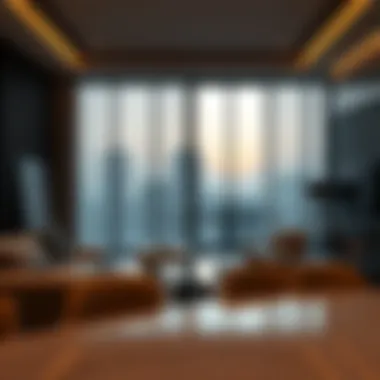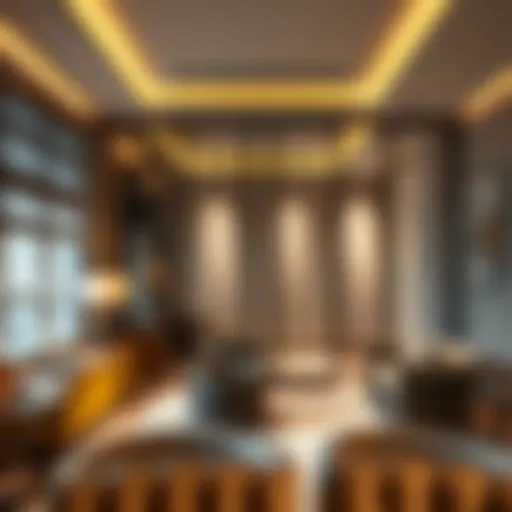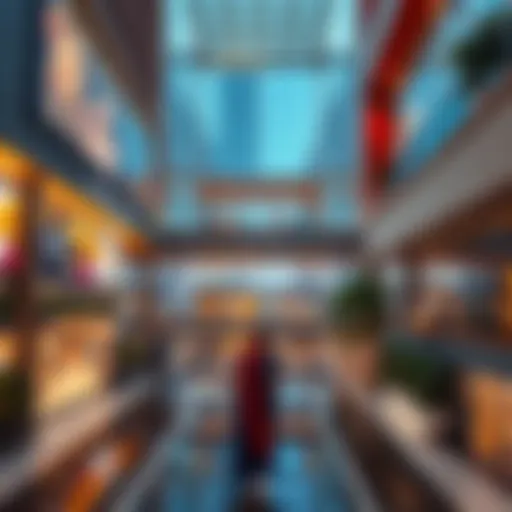Design Quarter: Blending Aesthetics and Functionality


Intro
The notion of design quarters has been a heated topic lately, especially in the context of rapidly evolving urban landscapes like Dubai. This slice of city life, where aesthetics blend seamlessly with functionality, is not just a modern trend—it's a critical aspect of how urban living is shaping up.
In Dubai, where the skyline competes with the imagination, the design quarter serves as a canvas for both artistic expression and practical living. It’s important to recognize how factors like architecture, sustainability, and cultural influences are deeply intertwined in these districts. Each corner reflects a unique marriage of style and utility that caters to diverse communities, enhancing the urban fabric.
Through the lens of design, we can examine how the city not only attracts tourists and residents alike but also investors seeking profitable opportunities in real estate. Understanding these themes is vital for anyone aiming to navigate the urban jungle of Dubai, whether you're a seasoned investor, a first-time homebuyer, or a diligent agent.
As we unfold this narrative, we will delve into the current market trends, future predictions, and practical tips for buying or renting in these vibrant quarters. By the end of this exploration, you’ll grasp the significance of design quarters in not just shaping Dubai but also enriching the lives of those within its bounds.
Understanding the Design Quarter
Understanding the concept of a design quarter is crucial for grasping how urban environments are evolving in today’s world. A design quarter represents more than just a physical location; it's a dynamic space where aesthetics and functionality meet to foster a cohesive urban experience. The importance of these areas stretches far beyond their visual appeal, impacting the way communities interact, engage with their surroundings, and even influence economic patterns.
Definition and Origins
The term "design quarter" often refers to specific districts within cities that are marked by a concentration of design activities. This could encompass anything from architecture to fashion, art, and industrial design. The origins of such quarters can usually be traced back to periods of significant economic transformation, where creativity spurred commercial growth. For instance, the industrial revolution in cities like London birthed neighborhoods like Shoreditch, known today for its vibrant creative community.
In recent years, cities across the globe have identified the potential of establishing such designated areas to enhance both cultural life and economic vitality. The mix of historic buildings with modern design sensibilities creates a tapestry that not only attracts tourists but also brings local communities together, paving the way for a vibrant cultural exchange.
Historical Context
Historically, the configuration of urban spaces has been shaped by various forces including industrialization, globalization, and, more recently, technological advancements. In the mid-20th century, urban designers began to recognize the detrimental effects of prioritizing functionality over aesthetics, which led to some uninspiring neighborhoods. This realization has propelled a shift back toward integrating design into the fabric of everyday city life.
For example, the revitalization efforts seen in places like Barcelona and New York demonstrate how neglect in design can lead to decay, while thoughtful restoration can breathe new life into a community. Through careful planning and architectural interventions, these cities turned once-dilapidated areas into thriving design quarters that now host a diversity of activities and attract diverse populations.
Global Perspectives
Globally, the concept of design quarters isn’t solely unique to a single culture or locale; instead, it manifests in various forms depending on local customs and societal needs. Cities like Milan, with its famed design week and fashion events, dishes out a plate of design that bolsters its identity on the global stage. Meanwhile, in Tokyo, distinct districts like Harajuku highlight how local youth culture influences and reshapes design aesthetics in public spaces.
Different contexts yield unique applications of the design quarter concept. From the artsy neighborhoods of Brooklyn to the historic charm of Lisbon’s Alfama district, understanding these variations can provide investors and buyers insights into emerging trends that can drive opportunities in real estate.
"Design quarters symbolize the fingerprint of a city—reflecting its history, culture, and aspirations in every corner and cobbled street."
In summary, comprehending the dynamics of design quarters can create pathways for enhancing quality of life while driving economic growth and social engagement. As urban landscapes continuously change, the significance of these quarters becomes increasingly profound, urging stakeholders to invest thoughtfully in their development and preservation.
The Role of Design in Urban Areas
Design plays a vital role in shaping our urban landscapes, acting as a bridge between aesthetic sensibilities and functional necessities. In the fast-paced world of urban development, the emphasis on design reflects a society's values, aspirations, and functionality requirements. Understanding this interplay is crucial for stakeholders, including investors, buyers, agents, and designers. The effective merging of aesthetics with functionality influences much more than mere appearances; it has far-reaching consequences on community development, economy, and the overall quality of life in urban settings.
Aesthetic Appeal vs. Functionality
One of the cornerstone debates in urban design is the balance between aesthetic appeal and functionality. Beautifully designed spaces can draw people in, yet if they don't serve a purpose, they risk falling flat. For instance, a striking plaza might be Instagram-worthy but could become irrelevant if it doesn’t meet community needs, such as seating or green spaces. A successful design quarter preserves visual allure while enhancing usability.
- Enhancing Public Spaces: Parks and pedestrian pathways adorned with art can elevate a city's charm, turning ordinary sections into vibrant areas for social interaction.
- The 10-Minute Rule: This urban planning concept advocates that all essential services should be within a 10-minute walk. Aesthetics play into this, as attractive designs encourage more pedestrian traffic.
Equally important is how these elements intermingle. A well-designed space offers avenues for relaxation and social interaction, ensuring people want to linger.
Influence on Community Engagement
Design isn’t merely about bricks and mortar; it’s also about fostering community connections. Thoughtful urban design encourages social interaction, which can lead to greater community cohesion. Take public squares or community gardens as examples. They serve as gathering points where neighbors can engage with each other.
- Social Connectivity Components: Wide sidewalks, café seating, and communal amenities create environments that invite people to converse. These spaces facilitate connections and contribute to a robust community fabric.
- Programming Events: Design can enhance community engagement through events such as farmers' markets or art fairs, which are made possible by adaptable urban spaces that cater to public gatherings.
As more people see their contributions available, they feel more invested in the area. Their involvement can lead to a sense of ownership, vital for maintaining vibrant urban quarters.
Design's Impact on Real Estate Value
It’s no secret that design can significantly influence real estate values. An area’s aesthetics—landscaping, facades, and public spaces—affect demand. Properties in well-designed quarters often see increased value, making them an attractive proposition for investors.


- Indicators of Value: Well-maintained public spaces lend credibility to surrounding properties, while proximity to aesthetically pleasing areas can enhance property appraisals.
- Luxury Market Trends: High-end developments often feature innovative architecture and designs that cater specifically to affluent buyers looking for both comfort and exclusivity.
"Investors are increasingly recognizing that design impacts not just aesthetics but overall investment performance in real estate."
In summary, understanding the role of design in urban areas is essential for those involved in real estate and community planning. The convergence of aesthetic appeal and functionality isn't merely about creating beauty; it’s about fostering communities, enhancing property values, and ensuring sustainability in urban environments. Furthermore, as urban landscapes evolve, ongoing dialogues about these concepts will shape future developments.
Architectural Trends in Design Quarters
In the context of design quarters, architectural trends do more than just embellish an urban area; they set the blueprint for how communities engage with their space. These trends are pivotal, as they reflect the evolving standards of living and the increasing focus on environmentally responsible façades and layouts. Balancing aesthetics with functionality becomes crucial in this arena, impacting not only how buildings appear but also how they serve their residents and the broader community.
Sustainable Design Practices
Sustainable design practices form the backbone of many architectural projects within design quarters. The primary goal is to reduce environmental impact while maximizing energy efficiency. This can manifest in various ways, such as the integration of green roofs, which not only provide insulation but also absorb rainwater and improve air quality. For example, in Singapore, the Gardens by the Bay showcases how sustainable architecture can blend beautifully with urban landscapes, promoting biodiversity while offering aesthetic appeal.
Beyond aesthetics, though, these practices also consider the economic implications. Implementing energy-efficient systems, like solar panels or innovative HVAC solutions, assists in lowering utility costs for both businesses and residents. Thus, sustainability is not merely a fleeting trend; it’s an essential practice integrating long-term cost savings with environmental stewardship.
Sustainable architecture requires that we rethink our role in shaping both the built environment and the natural world.
Innovative Materials and Techniques
The advent of innovative materials and construction techniques significantly impacts design quarters. Modern-day architects are no longer confined to traditional building materials. With advancements in technology, we now see the rise of materials such as reclaimed wood, bamboo, and high-performance glass that contribute to both durability and visual appeal.
These materials embody a blend of old and new, allowing for unique design opportunities. For instance, in Barcelona, architects utilize textured concrete and organic shapes, resulting in a distinct community atmosphere. Techniques such as 3D printing and modular construction are also gaining traction, offering flexibility and efficiency in building processes. They not only reduce waste but also streamline construction timelines, a crucial consideration in bustling urban settings. This shift signals a necessary adaptation to meet contemporary demands while enhancing community aesthetics and functionality.
Cultural and Regional Influences
Architecture never exists in a vacuum. Cultural and regional influences often play a decisive role in shaping design quarters. Local traditions, history, and environmental conditions inform architectural choices, ensuring that buildings resonate with their surroundings. This interplay is particularly notable in places like Tokyo, where innovative designs respect historical elements, blending the past with the present seamlessly.
In addition to aesthetics, these influences pave the way for community identity. Recognizing that a building is more than just a structure, architects often intertwine local artistry and cultural narratives into their designs.
- In regions like Morocco, the intricate tile work and bright colors reflect the local heritage, while simultaneously adopting modern design sensibilities.
- Alternatively, urban spaces in Berlin have seen a push towards multifunctional structures that accommodate diverse uses, echoing the city’s culture of inclusivity and adaptation.
Ultimately, the architectural trends observed in design quarters are reflections of their unique contexts. They embrace sustainability, innovative materials, and cultural narratives, producing environments that not only serve their immediate function but resonate profoundly with community values.
The Economic Implications of Design Quarters
The economic implications of design quarters play a pivotal role in understanding how these spaces function not only as aesthetic zones but also as economic engines within urban settings. When a district embraces design innovation, it often transforms into a vibrant hub that attracts a diverse array of investment opportunities, enhances job creation, and stimulates the real estate market. This section will delve into the various economic aspects of design quarters, emphasizing their significance and multifarious benefits for cities, particularly focusing on the thriving design quarter scene in Dubai.
Attracting Investment in Real Estate
Real estate investment in design quarters can be likened to planting seeds in fertile soil. These areas, often characterized by their unique aesthetics and vibrant atmospheres, become magnets for both domestic and foreign investors. As the demand for beautifully designed spaces rises, so does the potential return on investment. Key factors driving this trend include:
- Visual Appeal: Properties with compelling architecture and landscaping tend to draw higher bids, enhancing their market value.
- Proximity to Amenities: Design quarters often offer access to an array of shops, parks, and cultural venues, making them attractive to prospective buyers and tenants.
- Cultural Vibrance: An active cultural scene can raise the profile of a community, bringing in tourism and additional investment.
As investors realize the lucrative potential, areas such as Dubai's Design Quarter are witnessing significant capital influx, underscoring the transformative capacity of thoughtful design in real estate.
Job Creation in Design-Driven Areas
Design quarters are not just about bricks and mortar; they're about livelihoods. When a design quarter flourishes, an array of job opportunities arise across various sectors. In particular, the creative economy benefits greatly, leading to the establishment of roles such as:
- Architects and Interior Designers: Professionals are in demand for both new projects and renovations, injecting creativity into the community.
- Artisans and Craftspeople: From custom furniture makers to local art producers, these roles thrive in areas focused on design.
- Service Industry Jobs: Restaurants, cafes, and retail shops tend to proliferate in design-rich environments, creating job opportunities for locals.
The synergy between design and employment not only enhances the local economy but also fosters community pride and engagement. As people become invested in their communities, they contribute to a cycle that perpetuates economic growth.
Real Estate Market Trends in Dubai
Dubai’s real estate market has been undergoing remarkable changes, particularly in its design quarters. The city, known for its iconic skyline and extravagant developments, is keenly aware of the significance of aesthetics in urban planning. Current trends shaping the real estate landscape in Dubai include:
- Luxury Developments: High-end properties with cutting-edge designs command premium prices, attracting affluent buyers.
- Sustainability: Many projects now integrate green technologies and sustainable practices, appealing to a growing demographic of eco-conscious investors.
- Adaptive Reuse Projects: Converting existing buildings into trendy spaces is gaining popularity, infusing character while preserving history.


In summary, as Dubai continues to position itself as a global design hub, its real estate market reflects a dynamic interplay of design innovation and economic vitality. The evolution of these design quarters illustrates not only a shift towards enhanced living environments but also a broader understanding of how aesthetics impacts economic prosperity.
The Experience of Living in a Design Quarter
Living in a design quarter offers a distinct experience that intertwines artful aesthetics with practical functionality. These neighborhoods are not just clusters of buildings and pavement; they embody a lifestyle that prioritizes thoughtful design, sustainability, and community engagement. Understanding this experience provides deeper insights into how urban environments can enhance everyday life. Here, we will explore quality of life enhancements, the accessibility of amenities and services, and the importance of community and social interaction within design quarters.
Quality of Life Enhancements
Quality of life is a paramount concern for many individuals and families searching for the right place to call home. Design quarters, with their careful planning and unique architectural styles, can significantly elevate this quality. This enhancement often manifests through several avenues:
- Aesthetic Environment: The visual appeal of a design quarter can transform the daily routines of its residents. Beautifully designed streets and public spaces not only attract visitors but also instill a sense of pride in the locals who inhabit them.
- Well-Designed Spaces: Homes in these areas are typically built with a strong focus on functionality, often featuring open layouts and natural lighting, which foster a more pleasant living environment. Those larger windows don’t merely let in sunlight; they connect residents to the vibrant surroundings.
- Well-being & Mental Health: Green spaces and parks, often integrated thoughtfully throughout design quarters, promote outdoor activities and social gatherings. Studies indicate that access to nature reduces stress and improves overall happiness.
In summary, living in such areas creates a holistic experience that enriches daily life through its environment.
Access to Amenities and Services
In the fast-paced urban landscape, accessibility can make or break the living experience. Design quarters are strategically developed to ensure that vital amenities and services are within reach:
- Proximity to Essentials: Grocery stores, healthcare centers, and pharmacies are often strategically located within walking distances. This ease removes commuting burdens and allows residents to spare more time for leisure.
- Recreational Options: The presence of cafes, restaurants, and cultural institutions means that residents can enjoy local eats and arts without stepping far. Imagine grabbing a weekend brunch just blocks away, relishing new culinary adventures every time.
- Public Transport: Efficient public transport networks are usually well-integrated into the design fabric, allowing residents to navigate the city seamlessly. This not only increases connectivity but also reduces personal transportation costs, contributing to a lighter carbon footprint.
Access to robust amenities not only improves convenience but also enhances satisfaction, making these quarters appealing to a variety of demographics.
Community and Social Interaction
The heartbeat of a design quarter often resides in its community spirit. The architecture and layout encourage social interactions, fostering relationships among neighbors:
- Common Spaces: Parks, plazas, and art installations provide venues for community events. These public spaces serve as gathering points, where residents can participate in activities ranging from farmer's markets to art events, building stronger community bonds.
- Encouraging Local Engagement: By promoting local businesses, design quarters help in weaving a tapestry of relationships within the neighborhood. Shoppers meet shopkeepers, and friendships often blossom over shared interests.
- Cohesion and Diversity: Such spaces often attract a diverse range of people, leading to a rich exchange of ideas and cultures. Engaging with different perspectives not only enhances inclusivity but contributes to personal growth among community members.
The sense of belonging that comes from these social interactions in design quarters contributes immensely to the overall quality of life.
"Design quarters are places where living spaces are mentally and physically designed to enhance community engagement and elevate lifestyles."
In summary, the experience of living in a design quarter encapsulates much more than visually pleasing surroundings. It is a blend of quality living, ease of access to necessary services, and vibrant community interactions that collectively contribute to a fulfilling lifestyle.
Challenges Facing Design Quarters
The concept of design quarters, with their intricate blending of aesthetics and functionality, is not without its challenges. As urban planners, architects, and community members forge ahead in creating these vibrant spaces, they face several pressing issues. Understanding these challenges is crucial to advancing the design quarter concept in a sustainable and inclusive manner. Addressing these elements ensures that development does not overshadow the preservation of cultural heritage or the wellbeing of current inhabitants.
Balancing Development and Preservation
One significant hurdle designers encounter is finding that delicate balance between new development and preserving the existing community fabric. On one hand, there’s a push for modern designs, innovative materials, and flashy structures that attract higher investments. On the other hand, there’s a deep-rooted need to preserve the historical and cultural essence that gives life to these neighborhoods.
Key points to consider:
- Historical Significance: Buildings don’t just house people; they tell the stories of the past. Ignoring this is akin to wiping away history.
- Community Identity: Each neighborhood has its unique character. A design quarter should reflect this identity rather than erase it in pursuit of sleek designs.
- Sustainable Practices: Integrating new structures with existing ones can lead to eco-friendly solutions, utilizing energy-efficient technologies while still honoring the design ethos of the area.
It becomes vital for all stakeholders, from policymakers to designers, to engage in open dialogues with the community, ensuring that voices are heard and respected during development phases. Effective collaboration can lead to innovative solutions that preserve what matters most.
"A design quarter should nurture growth without sacrificing its roots.”
Coping with Gentrification Issues
Gentrification, while often associated with positive economic revitalization, also brings a host of challenges. As design quarters develop, rising property values can lead to the displacement of long-term residents and small businesses, which are often the foundation of these communities. This results in a cultural shift that can dilute the very essence of what makes design quarters special.
Several considerations must be taken into account:
- Affordable Housing Initiatives: There’s a pressing need for policies that keep housing accessible for all income levels. Without this, we run the risk of fostering inequity in areas designed to promote community.
- Support for Local Businesses: It’s crucial to ensure that small businesses can thrive in these areas. Incentives for local shops can help keep the community's character alive.
- Engagement Programs: Establish programs that involve residents in the decision-making process about changes within their community. This could help mitigate feelings of alienation.
Real care must be taken to create a design quarter that respects and uplifts the existing community, rather than transforming it into something foreign. Successful design practicies can act as a model for future urban areas.


Addressing Environmental Concerns
As development in design quarters expands, environmental concerns take center stage. The modern world pushes for sustainability, and urban design must converge with ecological consciousness. Neglecting this element can create long-term repercussions that outweigh the short-term benefits of stylish aesthetics.
Important aspects to tackle include:
- Green Spaces: Integrating parks and open areas can enhance community wellbeing while supporting biodiversity.
- Sustainable Construction: Emphasis on eco-friendly materials and practices that reduce carbon footprints can transform how buildings are created and maintained.
- Public Transportation Solutions: Encouraging efficient public transport systems reduces traffic congestion and promotes a lower carbon impact. This in itself can foster community connectivity.
Urban design needs to reflect a commitment to sustainability, equipping future generations with spaces that are not only beautiful and functional but also considerate of the planet’s health. Attention to these challenges can propel design quarters into models for future urban planning efforts, where style and substance walk hand in hand.
Case Studies of Notable Design Quarters
Exploring case studies of design quarters reveals valuable insights into the social, economic, and cultural ramifications of such urban environments. These exemplars illuminate how thoughtful design can foster community relationships, enhance real estate values, and create spaces that are both functional and aesthetically pleasing.
Examples from Around the World
Several noteworthy design quarters stand out globally, each showcasing unique approaches to combining beauty with purpose:
- The Meatpacking District, New York City: Originally an industrial hub, it has undergone a dramatic transformation into a vibrant district filled with upscale boutiques and restaurants, maintaining a rugged charm that pays homage to its origins.
- Shoreditch, London: Known for its street art and tech start-ups, this area balances modern aesthetics with historical architecture, appealing to artists and professionals alike.
- Zürich West, Switzerland: This area exemplifies a successful mix of residential and commercial spaces. By integrating parks and community centers, it becomes a model of how design can enhance urban living.
- La Défense, Paris: A quintessential example of a business district, showcasing cutting-edge architecture and an abundance of green spaces, which has made it attractive for corporations and start-ups.
"In understanding the dynamics of a design quarter, one realizes that aesthetics are not merely superficial; they are integrally tied to the community’s fabric."
The Dubai Design Quarter: A Closer Look
The Dubai Design Quarter, or d3, stands as a beacon of creativity in a city known for its architectural feats. Incorporating both local cultural elements and avant-garde design, d3 aims to be the heart of Dubai's design scene.
Its open-air layout facilitates a seamless flow between public and private spaces, encouraging community interaction while showcasing high-end galleries, studios, and showrooms. Key features include:
- Sustainable Design: Use of energy-efficient materials and innovative building techniques serves as a model for future developments.
- Cultural Hubs: Regular art exhibitions and events cultivate a rich tapestry of cultural exchange, drawing a diverse audience.
The quarter's design, which includes ample green spaces and communal areas, significantly enhances the overall quality of life for its inhabitants.
Lessons Learned from Global Practices
By examining various international design quarters, there are critical takeaways that can inform future developments, especially for regions looking to enhance their urban landscape:
- Community Involvement: Local input in the design process leads to projects that resonate more with the public, ultimately fostering loyalty to the area.
- Flexibility in Design: Spaces that can adapt to different uses over time tend to remain relevant and can evolve as community needs change.
- Integration of Nature: Urban green spaces are not just pleasant to look at; they improve mental well-being and promote social interactions among residents.
These lessons are vital for stakeholders, as investing in thoughtful design holds the key to creating vibrant, thriving neighborhoods.
Future Directions for Design Quarters
Understanding the future directions for design quarters is paramount in navigating the evolving urban landscape. These spaces are not just mere physical locations, but rather intricate ecosystems where aesthetics meets practicality. With a growing emphasis on sustainability, the design quarter is evolving into a pivotal realm of urban development, aimed at enhancing both community welfare and economic viability. Investors, buyers, agents, designers, and analysts are increasingly focused on how these areas will perform in the future, impacting the decisions they make in investing and designing urban spaces.
Emerging Trends in Design and Architecture
The architectural landscape is not static; it’s a diamond that keeps evolving under the pressures of modern demands. One key trend is adaptive reuse. Rather than building anew, many developers are choosing to breathe new life into old structures. This approach not only preserves historical context but also reduces waste and respects the environment. A notable example of this can be seen in the transformation of warehouses into vibrant living spaces in areas like Brooklyn.
Moreover, the integration of biophilic design—which incorporates elements of nature into urban settings—has gained traction. This concept emphasizes natural light, greenery, and organic materials, making spaces more inviting and mentally soothing. In cities like Singapore, vertical gardens and green rooftops have redefined the urban skyline while improving air quality.
- Flexibility in Design: As the world changes rapidly, spaces that can adapt their function are becoming essential. This could mean transformable spaces that can seamlessly shift from a café during the day to a community meeting space in the evening.
- Health-Centric Approach: With a growing awareness of health, design quarters are increasingly being shaped around wellness. Features such as natural ventilation, outdoor spaces for exercise, and noise reduction are becoming standard.
The Role of Technology in Design
Technology is a game-changer in the design quarter narrative. The surge in smart technology allows for the creation of responsive environments. Imagine a public space where lighting and temperature adjust based on user activity or comfort. With the Internet of Things (IoT) coming into play, data collected can help inform decisions about urban planning. For instance, if a particular area sees a rise in foot traffic, municipalities can allocate resources to improve that space accordingly.
Additionally, augmented reality (AR) and virtual reality (VR) are revolutionizing the way designs are conceptualized and proposed. An investor can walk through a virtual model of a space long before it’s physically built, helping them make informed decisions. In markets like Dubai, this technology not only aids designers but also provides a unique selling point in real estate.
Shaping Urban Spaces for Future Generations
When contemplating urban planning, it's important to keep the next generation in mind. As cities expand, the goal should not simply be expansion for growth's sake but enhancing the liveability of these design quarters. Crucial elements include:
- Inclusionary Design: Designing spaces that cater to diverse demographics, ensuring accessibility for everyone—regardless of age or ability. This approach enhances community bonds and encourages inclusivity.
- Sustainable Practices: Utilizing eco-friendly materials and focusing on renewability is a must. More cities are adopting green building certifications, promoting sustainable innovations that verbally resonate with eco-conscious citizens.
- Community-Centric Development: Involving community input in the design process so that the spaces reflect the needs and values of those who inhabit them. This can impassion residents and harness their investment in the community’s wellbeing.
The future of design quarters should aim not just for aesthetic appeal, but for creating collaborative spaces that foster social interaction, growth, and sustainability.
By focusing on these directions, design quarters will not only respond to current trends but also anticipate future needs. Engaging in dialogue with the community and integrating cutting-edge technologies will yield environments where individuals and families thrive, not just live.















